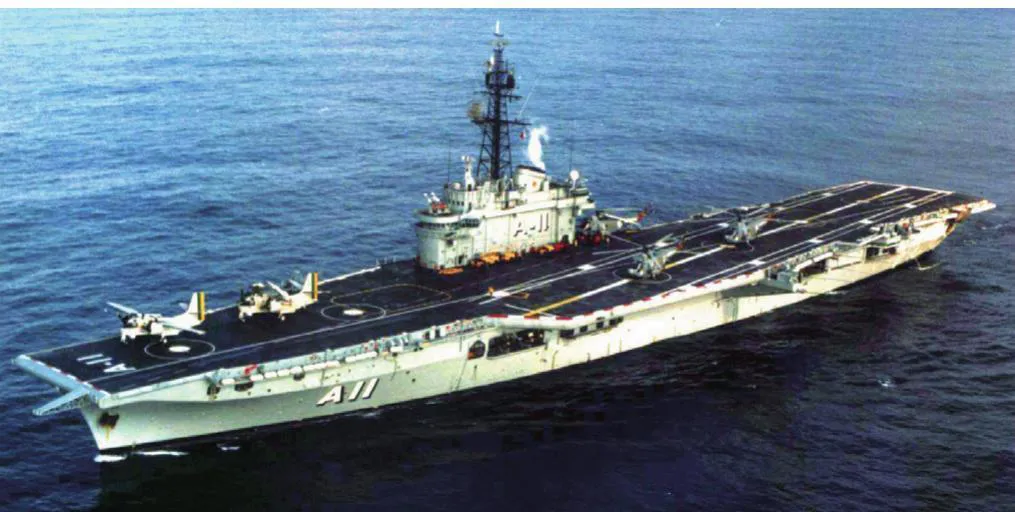Minas Gilas (Brazil)
After winning brazil's presidential election in 1955, Minas Gerais Governor Juscelino Kubitschek promised to buy an aircraft carrier for the Brazilian Navy, named after the State of Minas Gerais, where he once served, to appease opposition admirals who were dissatisfied with the election results. Brazil quickly took a fancy to the Giants, but they did not have the budget to buy a modernized aircraft carrier. So the Brazilian naval representative told britain that due to the shortage of funds, they could only buy aircraft carriers that had not yet been upgraded, and then complete the transformation by a third country with lower fees. As a result, on December 14, 1956, the British sold the Australian Navy's used Revenge to Brazil for only $9 million; the ship still retained direct deck, late World War II anti-aircraft weapons and electronics, and the power system was in good condition.
Since the Dutch had already modified the Giant-class aircraft carrier Karel Durman and offered a lower price than the British shipyard, the Revenge arrived at the Port of Rotterdam in the summer of 1957 for a modern conversion at the Former Shipyard. An 8.5° angled deck was added to the ship's starboard side, and more outer floating structures were added on both sides of the flight deck to expand the usable area. The thrust of the steam catapult at the bow was increased to 9.1 tons, and the blocking cable and elevator were also replaced at the same time to accommodate the normal operation of the new jet fighter. The ship island building on the starboard side was dismantled and replaced with a smaller size, and radar and electronic equipment were replaced with uniform Dutch equipment, and lens-assisted descending equipment was added to the starboard side. As a result of this modification, the displacement of the ship was increased to about 16,000 tons, the maximum speed was still 25 knots, and the self-defense firepower was changed to 10 40 mm "Bofors" anti-aircraft guns. Although the Dutch offer was quite favorable, the cost of the renovation of the whole ship reached 27 million US dollars due to the excessive installation of new equipment.
On 6 December 1960, Revenge was officially incorporated into the Brazilian Naval Order of Operations at the Port of Rotterdam and was named Minas Gerais. In order to equip the carrier-based aircraft, the Brazilian Navy subsequently proposed to the United States at a low price to purchase 6 S2F-1 "Searcher" anti-submarine aircraft and HSS-1 "Sea Bat" helicopters at a low price according to the "Mutual Defense Assistance Program". However, this decision immediately triggered a conflict between the Brazilian Navy and the Air Force, because the Brazilian Air Force had already incorporated all the combat aircraft owned by the Army and the Navy when it was formed, so the Air Force always refused to issue flight licenses and permits for aircraft carrier pilots trained at the Naval Aviation Academy, and threatened to shoot down the Navy aircraft as soon as it was found to have taken off without authorization. In this infighting, after returning to the port of Rio de Janeiro at the end of January 1961, the Minas Gilas had to sail without carrier-based aircraft. That situation didn't change until Humberto Branco, a former army soldier, took office as the new president in April 1964. At the president's mediation, the Air Force allowed carrier takeoffs and landings, but the Searcher anti-submarine aircraft squadron was controlled by the Air Force, while the Navy managed the Sea Bat anti-submarine helicopter squadron. Due to the single function of the combat aircraft, the Minas Gilas was more likely to be used only as a command ship for anti-submarine task force formations when it was finally decommissioned.
Beginning in 1976, the Minas Gerais underwent a four-and-a-half-year refit, with combat datalinks and the U.S.-made SPS-40B anti-aircraft radar to operate in conjunction with the new Niterói-class frigates. However, the 40-year-old aircraft carrier frequently fails due to aging equipment. During the 1987 Dragon 23 maritime exercise, its catapult malfunctioned and could not be repaired, so it had to transfer the carrier-based anti-submarine aircraft to a land-based airfield, while it was used as a transport ship for the Marine Battalion. From July 1991 to October 1993, the ship overhauled all its main engines and boilers, installed the SINCONTA combat command system, ZW-06 navigation radar and Northwest Wind ship-to-air missile, but was still unable to take off fixed-wing aircraft. It was not until the Brazilian Navy purchased the decommissioned May 25th catapult from Argentina in 1997 that the embarrassing situation of the carrier being unable to catapult take off was resolved. The Brazilian Navy still wants to take off and land jet carriers on aircraft carriers. They spent $70 million in 1999 to buy 20 A-4KU A-4KU strikers and 3 TA-4KU trainers from Kuwait. However, the weather did not go against people's wishes, the badly damaged "Minas Gilas" had reached the upper limit of service at this time, and the steam turbines, boilers and catapults used on the ship had been discontinued for many years, and in order to take off and land the "Skyhawk" attack aircraft, new steam catapults had to be replaced. After much deliberation, the Brazilian Navy finally decided on October 16, 2001, to retire the aircraft carrier, which had been in service for nearly half a century, and then towed it to India in July 2004 to disintegrate.
